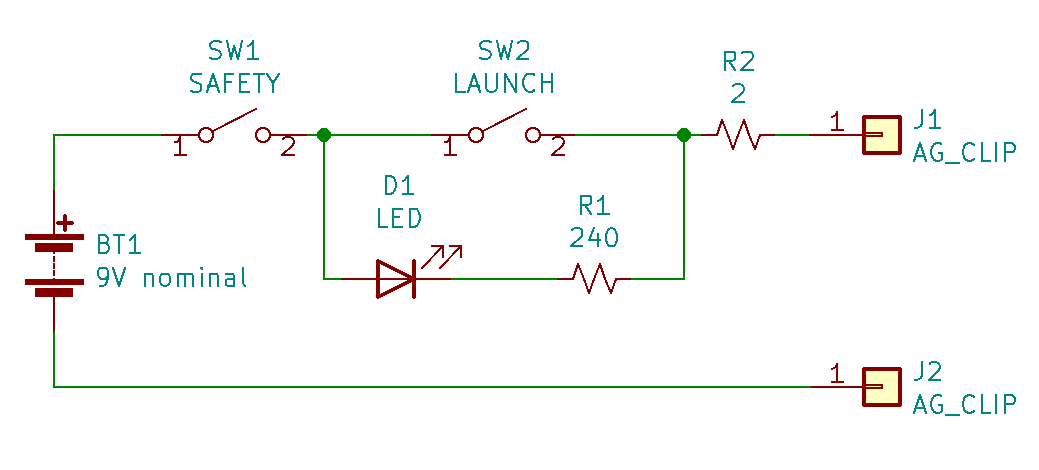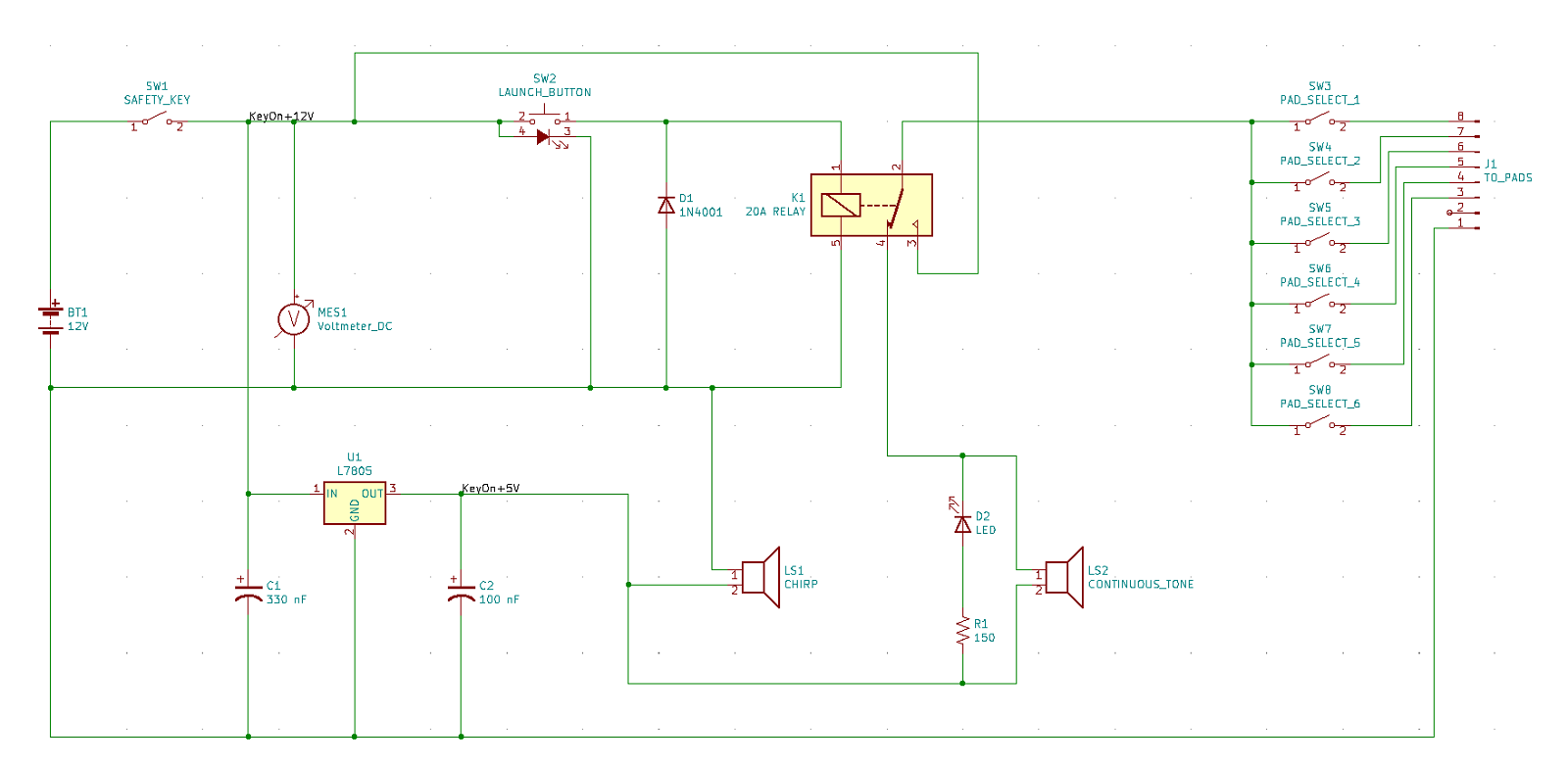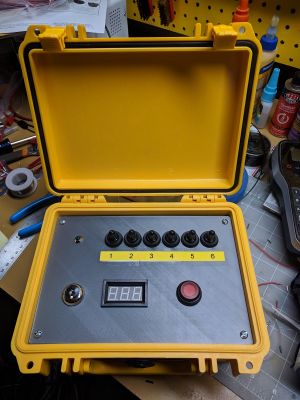Launch Controller Design
Motor igniters (starters)
The purpose of a launch controller is to activate a motor igniter, and thus ignite a motor. There are several different kinds of igniters, but they are fairly similar in electrical characteristics. The terms "igniter" and "starter" are often used interchangeably by rocket flyers; manufacturers usually use the term "starter" to demonstrate compliance with the regulations on shipping and mailing them.
Nominal resistance is just the resistance of the igniter, including its leads. No-fire current is the maximum current that can be passed through the igniter (to check continuity) when ignition is not intended. All-fire current is the minimum current that should be passed through the igniter when ignition is intended. Therefore, the continuity circuit must deliver less than the no-fire current to all igniter types, and the launch circuit must deliver more than the all-fire current to all igniter types.
There are still lots of blank cells in the table below - if you know where to find data on these, or would like to do some testing on your own and report your results, please contact Danno.
| Igniter Type | Nominal resistance | No-fire current | All-fire current |
|---|---|---|---|
| AeroTech Copperhead | |||
| AeroTech First Fire | |||
| AeroTech First Fire Jr. | |||
| AeroTech First Fire Mini | |||
| Estes Model Rocket Starter | 0.5 - 2 ohms[1] | 1 amp[1] | |
| Estes Sonic | 1.6 ohms[2] | 1.25 amps[2] | 3.80 amps[2] |
| Firewire | 0.8 - 1.2 ohms[3] | 0.3 amps (less than 0.04 amps recommended)[3] | 0.6 amps (1 amp recommended)[3] |
| Firewire Mini | 0.8 - 1.2 ohms[4] | 0.3 amps (less than 0.04 amps recommended)[4] | 0.6 amps (1 amp recommended)[4] |
| MJG e-match (dip-your-own) | 0.8 - 1.3 ohms[5] | 0.3 amps[5] | 0.7 amps[5] |
| Quest First Fire Micro | |||
| Quickburst Twiggy | 1 - 2 ohms[6] | ||
| Quickburst Slim Gem | 1 - 2 ohms[7] | ||
| Quickburst Fat Boy | 1 - 2 ohms[8] | ||
| Quickburst Super Fat Boy | |||
| Wildman Big-Uns | |||
| Wildman Little-Uns | |||
| Wildman Tiny |
Note that proper continuity circuit design is much more critical from a safety standpoint; too little current from the ignition circuit just means the rocket doesn't launch, but too much current from the continuity circuit can cause unintended ignition! In general, test current should be the minimum required to activate whatever lamp or sound device you're using to signal continuity (for instance, this LED specifies 30 mA maximum, and this alarm element only requires 7 mA). You should really never be getting anywhere close to the no-fire limits listed above.
The maximum firing current you can deliver will probably have more to do with the characteristics of the battery being used than the design of the launch circuit. Generally speaking, batteries with larger cells can deliver more current. This makes standard nine-volt batteries one of the least desirable choices, as they are actually six tiny 1.5 volt cells connected in series; a pack of six AA batteries, although larger and heavier, will be able to deliver more current to the igniter. At club launches, where many rockets will be launched over the course of a day, it is common to see a launch controller powered by a large 12V battery such as a car battery or lawn tractor battery. (TODO: try to compile some data about different types of batteries.)
Basic Controller Design

At its simplest, a safety-code compliant launch controller will consist of the components shown above. A battery is connected first to a safety interlock switch, sometimes called a safety key. This does not have to be a literal key (although it can be), but it must be something that can be physically removed from the launch controller to render the circuit safe with zero chance of an unintended ignition. The handheld controller which comes with Estes starter kits uses a small pin that is inserted in a hole to arm the system and removed to make it safe. In Days of Yore, this safety key would be tethered to the plastic cap intended to keep you from poking your eye out on the launch rod, so you couldn't forget to remove that cap before launch; Estes seems to no longer do this, though.
With the safety switch closed, the continuity circuit is active. Current from the battery flows through the closed safety switch but not through the launch button (since the button is not pressed yet), causing it to instead flow through the LED and resistor R1. The resistance of R1 is chosen based on the battery voltage to restrict the continuity current to an appropriate value for the LED and to prevent the current from exceeding the no-fire limit of any igniter which may be connected (see above). Finally, a second resistor may be used to restrict the launch current, if necessary to avoid damaging the battery. When the launch button is pressed, the resistance of the circuit becomes the sum of R2, the resistance of the igniter, the resistance of the wiring and the internal resistance of the battery, which may only add up to a few ohms, so a 2 or 3 ohm resistor here can be a significant control on the current.
Ohm's Law
The foundation of circuit design is Ohm's Law, which states that the voltage across a resistor (measured in volts) is equal to the current (measured in amperes, or amps) passing through the resistor multiplied by the resistance (measured in ohms). This is frequently written as V = I x R, but for this purpose we will rearrange it as R = V / I. Given a certain voltage supplied to the circuit and a certain current that is desired, what resistance must be used?
This equation must be solved twice - once for the launch circuit and once for the continuity circuit. The launch circuit only has one variable, so that should be done first:
Rwire + Rigniter + R2 = Vbattery / I
Looking at different igniter types in the table above, we'll estimate 1 ohm for the igniter and aim for a launch current of 2 amps.
Note: data sheets for common alkaline batteries seem to be reluctant to publish a maximum current value, but random Googling is telling me that two or three amps is not unreasonable for alkaline AA cells, especially since the demand is only for a few seconds. A TODO for this page is finding better battery data. When designing around different kinds of batteries it is important to be aware of their current limitations, especially when using rechargeable batteries as different types have very different characteristics and can be damaged (even to the point of catching fire or exploding) if discharged beyond their limits. Lithium-ion batteries are usually packaged with a circuit to keep their discharge rate within safe limits, but not always. Battery University appears to be a good resource for general battery information.
In this example, the battery used is a pack of six disposable alkaline AA cells in series, nominally 9 volts but with a measured voltage of 9.5 volts when brand new. The measured resistance of the wire (30 feet of audio speaker wire) is approximately 1 ohm. The equation for the launch circuit is:
Rwire + Rigniter + R2 = Vbattery / I
1 + 1 + R2 = 9.5 / 2
R2 = 2.8 ohms
As the designer, you can decide whether to round that value up or down, but it's good practice to plug the actual value back into the equation to make sure the current is still reasonable. Rounding down to a 2 ohm resistor will increase the current, so let's try that first:
1 + 1 + 2 = 9.5 / I
2.4 amps = I
That seems reasonable, especially since the voltage may droop a bit as the batteries run down, so we'll stick with R2 = 2 ohms.
A slight complication for the continuity circuit calculation is the fact that the LED, like all diodes, does not behave like a resistor. Instead, it is accounted for as a constant voltage drop regardless of the amount of current delivered to it (within reason). The voltage and current values will be found on the data sheet for the LED. For instance, the data sheet for the LED used in the example circuit gives the "forward voltage" as 2.1 V typical, 2.6 V maximum, and the ideal drive current as 30 mA maximum. The equation for this continuity circuit is:
R1 + Rwire + Rigniter + R2 = (Vbattery - VLED) / I
Now, the desired current is 0.03 A (30 milliamps) and we already know the value of R2:
R1 + 1 + 1 + 2 = (9.5 - 2.1) / 0.03
R1 = 240 ohms
As you can see, the 4 ohm resistance of the launch circuit is not significant compared to the resistor needed for the continuity circuit.
Congratulations! You just designed a launch controller.
Advanced Controller Design


Shown here is a launch controller design I have made a couple of iterations of for my club. The most recent version used a small Pelican Case as the enclosure. This controller uses large clamps to connect to an external 12V lawn tractor battery and has no current limiting resistor, so it can theoretically deliver several amps of current. It connects to a six-position launch rack and can select multiple pads at once, so the high current capacity can support clusters and multiple-rocket launches. A relay is used in the launch circuit to eliminate the pushbutton from the high-current path. A digital voltmeter displays the battery voltage.
The CED-ME516AQSW alarm element from Challenge Electronics (purchased through SparkFun Electronics) was used for LS1 and LS2 in this design. This is a very loud alarm which can be configured via a DIP switch to produce one of 15 different tone patterns. A quick chirp is used for LS1, to alert that the range is hot (safety key turned on), and a solid tone is used for LS2, to alert that a pad is selected, has good continuity, and is ready to launch. An LED is also provided as a visual continuity indicator, as in the previous design. The alarm device can run on 12 volts, but is uncomfortably loud; a voltage regulator (U1) is used to reduce the alarm voltage to the minimum of 5 volts (still extremely loud). Note that the continuity current is the sum of the current driving the LED (this LED from AllElectronics was used, drawing about 20mA with the 150 ohm current limiting resistor) plus the current driving the alarm (25 mA maximum at 5 volts) - 45 mA total.
TODO: complete parts list
References
- ↑ a b https://www.apogeerockets.com/Rocket_Motors/Estes_Accessories/Estes_Starter_6pk (1/18/2021)
- ↑ a b c https://www.apogeerockets.com/Rocket_Motors/Igniters/Estes_Sonic_Starter (1/18/2021)
- ↑ a b c https://www.apogeerockets.com/Rocket-Motors/Motor-Starters/Firewire-Initiator-6-pk (1/18/2021)
- ↑ a b c https://www.apogeerockets.com/Rocket-Motors/Motor-Starters/Firewire-Mini-Initiator-6-pk (1/18/2021)
- ↑ a b c https://www.apogeerockets.com/Rocket-Motors/Motor-Starters/E-match-Starter-Kit (1/18/2021)
- ↑ https://www.apogeerockets.com/Rocket_Motors/Motor_Starters/Twiggy_Starter (1/18/2021)
- ↑ https://www.apogeerockets.com/Rocket_Motors/Motor_Starters/Slim_Gem_Starters (1/18/2021)
- ↑ https://www.apogeerockets.com/Rocket_Motors/Motor_Starters/Fat_Boy_Starters (1/18/2021)
